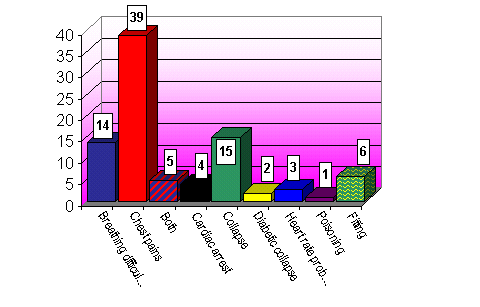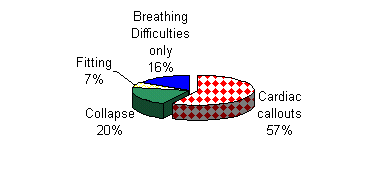Now it is classed as a "no brainer" that we have it!
Updated May 03
Oxygen arrived at 6 pm on 17th July, two of us had a training session off Ralph at 6:05 pm and we had a breathing problem call-out at 9 pm!
Note that we have a system where we use our 02 masks and the ambulance personnel replace it with a new one at the scene. This appears to have evolved without any formal procedure. I can only thank the crews who remember to throw me a mask as I seem to have a regular memory lapse when it comes to asking for the replacement.
The trial Stats from 17th July 02 to 17th May 03-
Pain types when 02 administered


Note: Cardiac callouts also include some breathing difficulties + chest pain.
The following is just the first part of the 13 page report.
There have been significant improvements noticed in:
a. Colour,
b. Pain
c. Breathing and
d. Anxiety level.
There is absolutely no doubt that oxygen therapy has benefited patients in this trial. There is no real way to put on charts etc. the reduced distress, anxiety and pain that a person with breathing difficulties and/or chest pain feels. Usually we are on scene for only 5-15 minutes before an ambulance arrives, however to someone in real distress this is a very long time.
To be able to deliver 0xygen to patients suffering like this is
so much better than simply holding their hand and hoping that the ambulance is
on scene FAST whilst one tries to stop deterioration with words. (We might be
well trained but that is pushing it!).
Another benefit is that the paramedic arriving on scene can concentrate on drugs for the patient whilst the CPR is being done by First Responders. There is no immediate requirement to swap to a bag and mask-though this is a less unpleasant way of keeping the patient oxygenated.
What to do when the cylinders are down to ¼ full?
There is still quite a lot of 02 left, what we do is put the spare into the barrel bag and use up the cylinder until it hits the red zone, thus avoiding quite a lot of waste. (There is usually plenty left from the ¼full- red zone, about 15 mins).
Fire risk – it should stressed during training that mechanics etc. must take off their coveralls before attending a call-out (possible oil/grease contamination).
5.
Oxygen storage, transport and use
The cylinders are stored in barrel bags from SP services,
during a call-out it is
transported in the boot of a responders car (for a few minutes on the way to
and from callouts).
Magnetic signs are provided with the bags to slap on to the rear car as the
bag is put into the boot. Estate car owners are asked to secure the barrel bag
in some way.
When the weather is below freezing, we have specialist heaters awaiting
installation, but until then the 02 is removed from its storage box and put in
a ventilated, ignition source free cupboard.
At no time does the 02 come into contact with oil, grease or naked flames.
The 02 is kept in a signed, secure (locked) storage place at all times unless
transported on a call out.
When the 02 is in use a careful watch is kept regarding cigarettes etc.
The empty cylinders are replaced by Ralph Palmer, Divisional Team Leader. This is done either at Carlisle ambulance station or Flimby ambulance station, where documentation is kept recording the exchange of cylinders.
All the risks are covered in the training, therefore the risk assessments could actually be “toned down” as once risks are- examined, then they will probably be deemed negligible and therefore do not have to be recorded.
An example of this is the build up of oxygen, which is unlikely with these cylinders as it is impossible for the cylinder to be accidentally turned on, and there are two valves.
In addition the First Responders have been fortunate to have had an expert explain that the carbon fibre cylinders are far superior in strength and durability than those previously used by the ambulance service.
Basically the risk assessments now require revising as they were written before the oxygen had been used by First Responders.
However, if this was done in conjunction with a detailed look at the training then the standard of the assessments would be better. As the author of the risk assessments, (qualified in Health and Safety, and a Registered Safety Practitioner), I am quite happy to work with training personnel in order to do this. Otherwise I can simply revisit the risk assessments in the immediate future.
Since the trial began, the group has had 108 call-outs, of which there were 58 occasions when oxygen was administered.
The above statistical record demonstrates that the group realises that oxygen is a drug to be used selectively and only when appropriate. It also demonstrates that oxygen is not administered on an ad hoc basis, but only when deemed beneficial to the patient.
The improvement in condition has been dramatic in a number of patients with breathing difficulties and cardiac conditions.